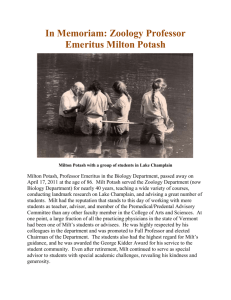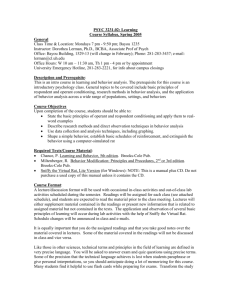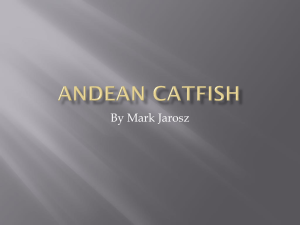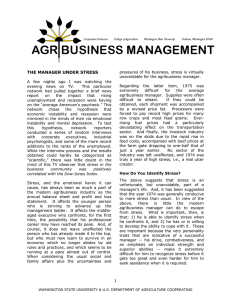Current Research Journal of Biological Sciences 2(6): 375-379, 2010 ISSN: 2041-0778
advertisement
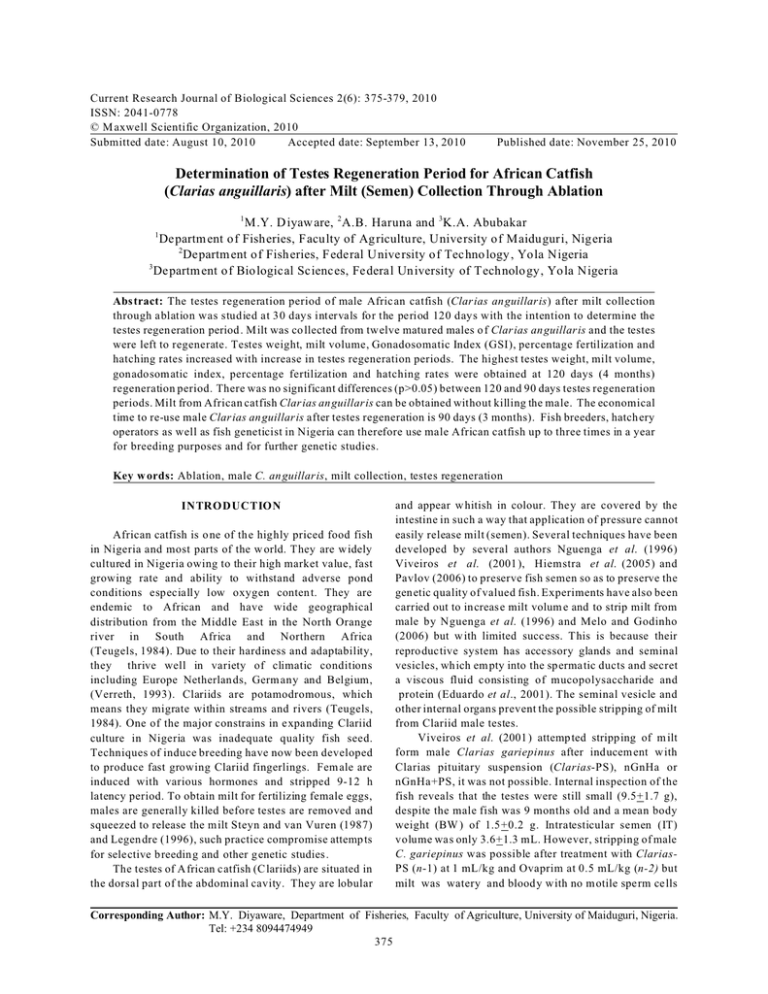
Current Research Journal of Biological Sciences 2(6): 375-379, 2010 ISSN: 2041-0778 © M axwell Scientific Organization, 2010 Submitted date: August 10, 2010 Accepted date: September 13, 2010 Published date: November 25, 2010 Determination of Testes Regeneration Period for African Catfish (Clarias anguillaris) after Milt (Semen) Collection Through Ablation 1 M.Y. D iyaw are, 2 A.B. Haruna and 3 K.A. Abubakar Departm ent of Fisheries, Faculty of Agriculture, University of Maiduguri, Nigeria 2 Departm ent of Fisheries, Federal University of Techno logy , Yola Nigeria 3 Departm ent of Biological Sciences, Federal University of Technolo gy, Yola Nigeria 1 Abstract: The testes regeneration period of male African catfish (Clarias anguillaris) after milt collection through ablation was studied at 30 days intervals for the period 120 days with the intention to determine the testes regen eration period . Milt was co llected from twelve matured males o f Clarias anguillaris and the testes were left to regenerate. Testes weight, milt volume, Gonadosomatic Index (GSI), percentage fertilization and hatching rates increased with increase in testes regeneration periods. The highest testes weight, milt volume, gonadosomatic index, percentage fertilization and hatching rates were obtained at 120 days (4 months) regeneration period. There was no significant differences (p>0.05) between 120 and 90 days testes regeneration periods. Milt from African catfish Clarias anguillaris can be obtained without killing the male. The economical time to re-use male Clarias anguillaris after testes regeneration is 90 days (3 months). Fish breeders, hatch ery operators as well as fish geneticist in Nigeria can therefore use male African catfish up to three times in a year for breeding purposes and for further genetic studies. Key w ords: Ablation, male C. an guillaris, milt collection, testes regeneration INTRODUCTION African catfish is o ne of the highly priced food fish in Nigeria and most parts of the w orld. They are w idely cultured in Nigeria owing to their high market value, fast growing rate and ability to withstand adverse pond conditions especially low oxygen conten t. They are endemic to African and have wide geographical distribution from the Middle East in the North Orange river in South Africa and Northern Africa (Teugels, 1984). Due to their hardiness and adaptability, they thrive well in variety of climatic conditions including Europe Netherlan ds, Germ any and Belgium, (Verreth, 1993). Clariids are potamodromous, which means they migrate within streams and rivers (Teugels, 1984). One of the major constrains in e xpanding Clariid culture in Nigeria was inadequate quality fish seed. Techniques of induce breeding have now been developed to produce fast growing Clariid fingerlings. Fem ale are induced with various hormones and stripped 9-12 h latency period. To obtain milt for fertilizing female eggs, males are generally killed before testes are removed and squeezed to release the milt Steyn and van Vuren (1987) and Legen dre (1996), such practice compromise attemp ts for selective breedin g and other genetic studies. The testes of African catfish (C lariids) are situated in the dorsal part of the abdominal cavity. They are lobular and appear w hitish in colour. They are covered by the intestine in such a way that application of pressure cannot easily release milt (semen). Several techniques have been developed by several authors Nguenga et al. (1996) Viveiros et al. (2001 ), Hiemstra et al. (2005) and Pavlov (2006) to preserve fish semen so as to preserve the genetic quality of valued fish. Experiments have also been carried out to increase milt volum e and to strip milt from male by Nguenga et al. (1996) and Melo and Godinho (2006) but w ith limited success. This is because their reproductive system has accessory glands and seminal vesicles, which em pty into the sperma tic ducts and secret a viscous fluid consisting of mucopolysaccharide and protein (Eduardo et al., 2001). The seminal vesicle and other internal organs prevent the possible stripping of milt from Clariid male testes. Viveiros et al. (2001 ) attemp ted stripp ing of m ilt form male Clarias gariepinus after inducem ent w ith Clarias pituitary suspension (Clarias-PS), nGnHa or nGnHa+PS, it was not possible. Internal inspection of the fish reveals that the testes were still small (9.5+1.7 g), despite the male fish was 9 months old and a mean body weight (BW ) of 1.5+0.2 g. Intratesticular semen (IT) volume was only 3.6+1.3 mL. However, stripping of male C. gariepinus was possible after treatment with ClariasPS (n-1) at 1 mL/kg and Ovaprim at 0.5 mL/kg (n-2) but milt was watery and blood y with no m otile sperm cells Corresponding Author: M.Y. Diyaware, Department of Fisheries, Faculty of Agriculture, University of Maiduguri, Nigeria. Tel: +234 8094474949 375 Curr. Res. J. Biol. Sci., 2(6): 375-379, 2010 after addition of water (Viveiros et al., 2003). Hatching rate was also very poor (4%) with stripped fluid from Clarias-PS + Ovaprim treated fish after sampling 24 h latency time. Viveiros et al. (2003 ) reported the possibility of stripping male Catfish injected with CarpPS (Carp pituitary suspension), after 12 h latency time (n-4). The absence of semina l vesicle extensions induced by treatment with 20 mg/kg17-"-methyltestosterone through feeding facilitated the collection of m ilt by stripping from C. gariepinus (Viveiros et al., 2001). Technique for collecting milt from Heterobranchus longifilis male without sacrificing the male have been described by (Nguenga et al., 1996). According to them, cicatrization of the cut occurred within 4 weeks and regeneration was within 2-3 months. Majorities of anesthetic proce dures in fish are accom plished by a dip or bath treatment in a static bath or with flowing water. Tranquil (Tricaine) MS-222, a sodium ch annel blocker is the only anesthetic approved for use in food fish Bow ser (2001), because it has a wide marg in of safety in a number of species including Clariid species. Male Africa n catfish , do no t release milt (semen) under abdominal massage in captivity and need to be killed in order to obtain milt for induced breeding exercise. Though milt collection from male African catfish after killing is effective for breeding purposes, it reduces the numbe r of males in the population which may bring shortage of male for further breeding and genetic improvement studies. Sometimes farmers have to kill 2-3 males before obtaining male that h as good m ilt despite the fact that the reddish genital papillae which indicates matured male has been observed. This is a major constraint in the catfish farming sub-sector. Stripping of milt from African catfish (C. gariepinus) was not po ssible due lack of gonadotrophin surge and presence of seminal vesicle and internal organs that blocks the flow of milt (Viveiros et al., 2001). In aquaculture, the availability of matured male and fema le throughout the year is important to ensure constant supp ly of fingerlings. There is need for alternative way(s) for milt collection from the male so as to avoid constant killing during fish seed production. Milt collection from Clariids through ablation (without sacrificing the male) has not been reported in Nigeria. There is also paucity of information on ideal regeneration time of African catfish testes after milt collection through partial removal of the testes (ablation ). The regen eration period of African catfish male testes after milt collection through ablation is necessary to save male population from dwindling sequel killing for the purpose of obtaining milt. The purposed of this study was to: investigate the possibility of obtaining milt from male African catfish (C. an guillaris) through ablation, determination of the testes regeneration period, and assessment of its po tency of the m ilt after regeneration. This is with view to determine the number of times in which the male African cat fish (C. anguillaris) could be used in a year for breeding purposes in Nigeria. MATERIALS AND METHODS The experiment was conducted between July to September 2009 at the Fish hatchery complex of Fisheries Department Alau, U niversity of M aiduguri, Nigeria located between latitude 13º86 ! N and 14º N and longitude 12º E and 13 ! E. Ra ining season beg ins in July and last in October in the stud y area. Experimental fish: Sexually matured males of C. anguillaris (517-570 g) from the wild were procured from fisherman in the Lake Alau. They were acclimatized in 10 m x 9 m x 1.2 m out do or con crete tan k. The male broodstocks were fed w ith 40% CP. commerc ial diet. The fish were observed regularly for features associated with ripeness. Sexually matured males were identified when the tip of the genital papilla was reddish. Twelve (12) matured males w ere selected from the concrete pond after draining. The ablation of the testes was carried ou t after surgical operation. To reduce stress during the surgical operation, each fish from each group was anaesthetized using Tranquil-MS 222 (Syndel International Inc. Canada) following the manufacturer’s instruction (2-3 drops/L of water) before operation. Each fish was dipped in the anesthesia until the fish was no longer active. The fish were removed from the anesthesia and placed on dorsal decumbency on a wet disinfected white cloth spread on clean table with the head covered with a piece of wet clean towel. The surface of the abdomen was disinfected with methylated spirit (40% alcohol) before an incision was made on the ventral side of the abdomen. The incision was extended towards the head with surgical scissors 3-5 cm long to expose the internal organs but remained intact. The digestive tract were lifted out and pushed aside to reveal the testes. About three quarter of the testes were removed and placed into a petri-dish containing physiological saline solution (0.9% NaC l) and preserved in refrigerator at 4ºC. The incisions we re sutured using simple interrupted suture pattern with catgut chromic 2/0. The surgery on each fish lasted for 10-15 min. Each fish was placed in a plastic trough with w ell aerated fresh water to enable them recover. After recovery from the anesthesia, each fish was placed into sep arate concrete tank (2 m x2 m x1 m indoors) containing O xtetracycline at dosage of 50mg/L for 5 days. The surgery and milt collection were performed in triplicates. 376 Curr. Res. J. Biol. Sci., 2(6): 375-379, 2010 Experimental design: After healing, the fish w ere grouped randomly into four (4) treatment groups 30, 60, 90 and 120 days. The fish were fed with 40% crude protein commercial feed fourteen (14) days post surgery. All the instruments used du ring the operations were disinfected with detol antiseptic. Testes regen erations we re examine d surg ically by reopening each treatm ent gro up. Testicular weight, milt volume and g onadoso matic index (GSI) before testes ablation and after regeneration from each fish we re recorded. The Gonadosomatic Index (GSI) of each male fish after testes regeneration was calculated according (Render et al., 1995): GSI = (GW /BW) × 100; where; GW = gonad weight and BW= body weight. Potency of the milt was tested out by fertilizing eggs from matured female. Before fertilization, the females were induced with 0.5 mL/kg ovaprim hormone. The females were stripped after 10 h latency period at 27-31ºC water temperature. Milt from each male after testes regeneration was used to fertilize stripped eg gs from each female. One teaspoon (about 1680) of the fertilized eggs using the milt from each of the treatment was incubated in plastic trough (0.8 m diameter x 0.45 m deep) under flow- through system. Fertilization and hatching rates of the eggs were record ed. Statistical analysis: Data obtained from the experiment were subjected to one-way analysis of variance , while means were compared for significant differences (p<0.05) using Duncan’s m ultiple range test Duncan (1955) using SPSS 11 for w indows. RESULTS All the fish that underwent surgical operation during 120 days testes regeneration trials healed 10-14 days post surgery (PS). No mortality was recorded. W ater temperatures range was 28.37-32.80ºC, while dissolved oxygen and pH ranges were 4.08-5.88 mg/L and 6.947.66, respectively (Table 1). After ablation , C. an guillaris testes w ere able to regenerate throughout the trial period (120 days). Table 2 show testicular w eight (g), milt volume and GSI of C. angu illaris after testes regeneration. The testicular weight, seminal volume and Gonadosom atic Index (G SI) increased with an increase in the regeneration periods (RGPs). The highest mean testicular weight (1.20 g) after testes regeneration was obtained in 120 days regeneration period followed by 90, 60 and 30 days RGPs respectively. There was no significant differences (p>0.05) between the testicular weight obtained during the 120 and 90 days RG Ps, while significant differences (p<0.05) existed between testicular weight values obtained during the 60 and 30 days RG Ps. Milt volume was higher (0.80 mL) during 120 days RGP period followed by 90, 60 and 30 (0.40, 0.40 and 0.20 mL) days respectively. There was no significant differences (p>0.05) between the milt volume obtained during 90, 60 and 30 days RG Ps. Water quality parameters: Dissolved oxygen (DO) and water temperature (ºC) were recorded with digital DO /temperature analyzer Model: JPB-608 DO while pH was recorded using digital pen pH meter Model: ATC pH/ºC both in the morning (08.00 h) and evening (18.00 h) local time daily. Table 1: Mean water quality parameters during testes regeneration after milt collection through ablation Water qualities --------------------------------------------------------------------------------------------------------------------------------T( o C ) DO2 pH -------------------------------------- ------------------------------------- -----------------------------------------Regen eration periods (days) Morning Evening Morning Evening Morning Evening 30 28.98 28.58 5.25 5.88 7.66 7.00 60 32.80 27.88 4.08 5.24 7.23 6.94 90 32.77 30.03 5.17 4.87 7.33 7.00 120 31.52 28.65 4.74 5.36 7.40 6.98 Table 2: Testicular weigh t, milt volume and G SI (Mean ±SD ) of C. ang uillar is after testes regeneration Regen eration periods (days) --------------------------------------------------------------------------------------------------------------------------------Param eters 30 60 90 120 Average Fish weight (g) 517.67 570.00 550.00 544.00 Average Total length(cm) 42.17±.0.72 41.80±0.92 42.23±2.89 43.83±1.69 Testes weight before regeneration(g) 1.53±0.64 a 1.83±0.50 a 1.47±0.31 a 1.90±0.36 a c b Testes weight after regeneration(g) 0.43±0.15 0.80±0.20 1.13±0.21 1.20±0.10 a M ilt vol. b efore rege nera tion (m l) 0.63±0.38 b 0.67 0.31 b 0.53±0.25 b 1.80±0.82 a M ilt vol. a fter reg ene ration (ml) 0.20±0.10 b 0.40±0.10 b 0.40±0.10 b 0.80±0.26 a b a a G S I b efo re re ge ne ra tio n (% ) 0.22±0.15 0.39±0.06 0.28±0.08 0.29±0.04 a b G S I a fte r re ge ne ra tio n (% ) 0.12±0.04 b 0.17±0.03 0.22±0.06 a 0.23±0.04 a Means with different superscript letters within a row are significantly different (p<0.05) 377 Curr. Res. J. Biol. Sci., 2(6): 375-379, 2010 Table 3: Percentage fertilization and hatchability (Mean ±SD ) of C. angu illaris milt after regenerated testes Regen eration periods (days) --------------------------------------------------------------------------------------------------------------------------------Param eters 30 60 90 120 No. of fert. eggs 1680 1680 1680 1680 No. of un-fert. eggs 440.33±260.90 a 382.67±41.18 a 358.33±59.00 a 286.67±30.55 a F ertiliz atio n (% ) 73.62±15.24 a 76.37±4.29 a 78.67 ±3.51 a 83.93±1.82 a No. of hatchlings 813.33±193.28 b 1181.70±129.45 a 1024.7067.68 a b 1241.00±42.58 a H atc ha bility (% ) 63.76±3.55 c 75.73±2.34 b 77.65±6.75 b 88.27±3.53 a Means with different superscript letters within a row are significantly different (p<0.05) GSI in the m ale C. anguillaris also increased with increase in the testes regeneration periods. The highest GSI (0.23%) was observed in 120 days RGP followed by 90, 60 and 30 days with 0.22, 0.17 and 0.12%, respectively. No sign ificant differences (p>0 .05) was observed statistically among GSI values recorded in 120, 90 and 60 days R GPs. Percentage fertilization and hatchability also increased with increase in testes RGPs (Table 3). Higher mean percentage fertilization and hatchability (83.330% and 88.27%, respectively) were recorded in 120 days RGP followed by 90, 60 and 30 days RGPs, respectively. There was no significant differences (p>0.05) between percentage fertilization observed throughout the RG Ps. Percentage hatchability during 120 days RGP w as higher and it is statistically different (p<0.05) from that of 90 and 60 days. The percentage hatchability values observed during 30 days of RG P was also statistically different (p<0.05) from the values obtained during 120, 90 and 30 days. Milt volume was able to develop to 31.75, 59.70, 75.47 and 44.44% in 30, 60, 90 and 120 days regeneration times, respectively. The highest GSI (0.23%) recorded during 120 days testes regeneration during this study was higher than the one recorded by El-Greisy and Shaheen (2007) for Mu gil ceph alis control during comparative studies on the effect of different hormones on GSI of the fish. All the GSIs observed during 30 to 120 days testes RGPs were higher than the GSI values reported by Viveiros et al. (2001) from stripped male C. gariepinus treated with 17- "methytestosterone 12-47 day s after ha tching. This is due to the fact that the stripped males we re una ble to produce much milt after injecting male C. gariepinus with m ale sex based hormone compared to those that regenerated naturally after ablation. The high p ercen tage fertilization and hatching rate (82 and 88.27%, respectively), observ ed in this study is higher than 4% reported by Viveiros et al., (2003) in stripped milt from C. gariepinus male after inducement with Clarias pituitary suspension (Clarias PS) and combination of Clarias PS and ovaprim. It is also higher than 63.1% hatching rate observed by Viveiros et al., (2003) from stripped milt of male C. gariepinus treated with 17- "-meth yltestoterone. These great differences in fertilization and hatching rates could be attributed to fact that stripped milt (semen) from male testes after treatment with 17- "-methyltestoterone could not have enough spermatozoa to fertilize the eggs from o ne fem ale compared to those obtained after testes regeneration. DISCUSSION The water quality parameters recorded during this study was within the recommendations of Viveen et al. (1985) for rearing of African catfish fish. Healing of the cuts occurred within 14 days post surgery in this study, it was earlier than th e work Nguenga et al. (1996) who reported that cicatrization (healing) of the cut occurred within 4 weeks (30 da ys) in male Heterobranc hus longifilis. This could b e due to differen ces in c limatic condition and species of fish. The increase in testicular weight, milt volume and GSI with increase in the regeneration periods observed in this study could be du e to longe r feeding time of the m ale broodstock after ablation might have given more times for the development of the gonads. The testes weight regenerated up 28.10, 43.1, 76.87 and 63.12% in 30, 60, 90 and 120 days RG Ps, respectively. Th e high er milt volume (0.8 mL ) obtained 12 0 day s during this study is similar to the values reported by Aral et al. (2007 ) in Oncorhynchus mykiss and low er than that of Cyprinus carp io (0.3 mL) as reported by (Y uehi and Chan g, 1997). According to them milt volume is one the features reflecting the milt yield and spermatozoa concentration. CONCLUSION Testes of male African catfish (C. an guillaris) were able to regeneration after milt (semen) collection through ablation from 30-120 days post surgery. The economical time to re-use male African catfish (C. an guillaris) after testes regen eration throug h ablation is 90 days. This means that it possib le to obtain milt from male C. anguillaris 3-4 times in one year through ablation for breeding purposes and later the sp ent males ca n be sold live. Male African catfish could also be re-used several times for further genetic studies in Nigeria through ablation owing to the erratic power supply that might hinder cryopreservation. Milt can be collected from a 378 Curr. Res. J. Biol. Sci., 2(6): 375-379, 2010 male African catfish without killing the fish. This will depend on the weather condition of the year. Proper and adeq uate feeding of the male after ablation is very necessary to hasten the develop men t of the gonads. Hatchery operator in N igeria can obtain m ilt from male African catfish three (3) months after ablation. This w ill give an op portunity of using one male 3-4 times in year. M elo, F.C.S.A. and H.P. Godinho, 2006. A protocol for cryopreservation of spermatozoa of the fish Brycon orthotaenia. Anim. Reprod., 3(3): 380-385. Nguenga. D., J.J. Breine, G .G. Teugels and F . Ollevier, 1996. Artificial propagation of the African Catfish Heterobranchus logifilis (Siluroidei; Claridae): Description of a simple technique to avoid sacrificing male broodfish for the obtaintion of milt. Aquaculture, 143: 215-217. Pavlov, D.A., 2006. A method for the assessment of sperm quality in fish. J. Ich thyol., 46(5): 391-398. Render, J.H., B.A . Thompson and R.L. Allen, 1995. Reproductive deve lopm ent of stripped mullet in lousiana estuarine w aters with notes on ap plicability of reproductive assessment methods for isochronal species. Trans. A m. Fish. Soc., 124(1): 26-36. Steyn, G.J. and J.H.J. van Vuren, 1987. Some physical properties of the m ilt from artificially induced sha rp tooth catfish (Clarias gariepinus). Comp. Biochem. Physiol., 86: 315-317. Teugels, G.G., 1984. The nomenclature of African catfish Clarias species used in aquaculture. Aquaculture, 38: 373-374. Viveen, W.J.A.R., C.J.J. Richter, P.G. Van Oodt, J.A.L. Janssen and E.A. Huisman, 1985. Practical manual for the culture of African catfish Clarias gariepinus, section for technical Research and Technology, Bos 2500 EB Hague, The N etherlands, pp: 121. Verreth, J., 1993. A review of feeding pra ctices, growth and nutritional physiology in larvae of the catfishes Clarias gariepinus and Clarias batracus. J. W orld Aquacult. Soc., 24: 135-144. Viveiros, A.T .M., E.H. Eding and J. Komen, 2001. Effect of 17- "-meth ytestosterone on seminal vesicle development and semen release in the African can fish C. gariepinus. Reproduction, 122: 817-827. Viveiros, A.T.M., Y. Fessehaye, M. ter-Veld, R .W . Schulz and J. Komen, 2003. Hand stripping of semen and semen quality after maturational hormone treatm ent in African catfish Clarias gariepinus. Aquaculture, 213: 373-386. Yuehi, S.W . and F.C. Chang, 1997. 17", 20$, 21trihydroxy-4-pregnen-3-one and 17 ", 20$Dihydroxy-4-pregnen- 3-one stimulated permeation in protandrous black porgy Acanthop agru s schlegeli. Fish P hysiol. Biochem ., 17: 187-193. ACKNOWLEDGMENT The are authors grateful to the co ntributions, of Dr. Paul B. Bo ko, Ve terinary Surgery D epartm ent, Faculty of Veterinary Me dicine, Dr. O.D. Sule and M rs. Erdoo Acha of Department of Fisheries all of University o f Maidug uri, Nigeria. REFERENCES Aral, F., E. Sahinoz and Z. Dogu, 2007. A study on the milt quality of Oncorhychus mykiss (Walbaum, 1972) and Carasobarbus luteus (Hech el, 1843) in A taturk Dam Lake, So utheastern T urkey. Tu r. J. Fish. Aqua. Sci., 7: 41-44. Bow ser, P.R., 2001. Anesthetic Options for Fish. In: Gleed, R.D. and J.W . Ludders (Eds.), Recent Advances in Veterinary Anesthesia and Analgesia: Companion Anim als, Pub. International V eterinary Information Service, Ithaca, New Y ork, USA. pp: 3. Retrieved from: www.ivis.org, (Accessed date: Aug ust 19, 2001). Eduardo, J.B., C. Jan-Bogerd, H. Goos and W .S. Rüdiger, 2001. Testosterone inhibits 11-ketotestosteroneinduced spermatogenesis in African catfish (Clarias gariepinus). Biol. Reprod., 65:1807-1812. El-Greisy, Z.A. and A.A. Shaheen, 2007. Comparative difference betw een the effects of Lh rh-a, 17- "Methyltestosterone pellets and HCG on reproductive performance of Mugil cephalus. J. Appl. Sci. Res., 3(9): 890-895. Hiemstra, S.J., T. van der Lender and H. Woelders 2005. The Potential of Cryopreservation and Reproductive Technologies for Animal Genetic Resources Conservation strategies. The Role of Biotechnology Villa Gualino, Turin, Italy, 5-7 March, pp: 12. Legendre, M., 1996 . BASIL - Biological bases for aquaculture of Siluriformes African catfish Clarias gariepinus. Ph.D. Thesis, W ageningen, Agricultural University, The Netherlands, pp: 155. 379
